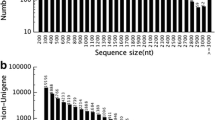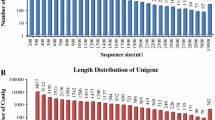Abstract
Osmanthus fragrans is a woody, evergreen species of shrubs and small trees that is extensively planted in sub-tropical and temperate climates as an ornamental plant in gardens and for its health benefits. The flower color ranges from ivory to orange to pink among different varieties and even color difference during the whole blossom in the sweet osmanthus. Sweet osmanthus is widely cultivated throughout China and other countries due to its prominent fragrance, colorful flowers, and medicinal properties. However, the scanty genomic resources in the Olea family have greatly hindered further exploration of its genetic mechanism on these economically important traits. In this study, transcriptome sequencing of O. fragrans was performed using the Illumina HighSeqTM2000 sequencing platform. Next generation sequencing (NGS) of the transcriptome of O. fragrans produced 31.7G of clean bases (211,266,818 clean reads) that were assembled into 256,774 transcripts and 117,595 unigenes. Of them, 197 and 237 candidate genes involved in fragrance and pigment biosynthesis respectively were identified based on function annotation. Meanwhile, 1 unnamed protein and 468 functional unknown genes were also identified. Furthermore, mRNA sequencing expression profiling of O. fragrans were compared to previous genes’. In summary, this comprehensive transcriptome dataset allows the identification of genes associated with several major metabolic pathways and provides a useful public information platform for further functional genomic studiesin O. fragrans Lour.







Similar content being viewed by others
Abbreviations
- GGPP:
-
Geranylgeranyl pyrophosphate
- PSY:
-
Phytoene synthase
- PDS:
-
15-Cis-phytoene desaturase
- ZDE:
-
Zeta-carotene desaturase
- PLYISO:
-
Prolycopene isomerase
- CRTISO:
-
Carotenoids isomerase
- β-LCY(LCYb):
-
β-lycopene cyclase
- εLCY(LCYe):
-
ε-lycopene cyclase
- ΒOH:
-
beta-carotene 3-hydroxylase
- ZE:
-
Zeaxanthin epoxidase
- VDE:
-
Violaxanthin de-epoxidase
- CCS:
-
Capsanthin/capsorubin synthase
- NS:
-
Neoxanthin synthase
- NCED:
-
9-Cis-epoxycarotenoid dioxygenase
- XDH:
-
Xanthoxin dehydrogenase
- AAO:
-
Abscisic -aldehyde oxidase
- AAH:
-
(+)-Abscisic acid 8′-hydroxylase
- CYP73A:
-
Trans-cinnamate4-monooxygenase
- CHS:
-
Chalcone synthase
- CHI:
-
Chalcone isomerase
- CYP93A:
-
Coumaroylquinate (coumaroyl shikimate) 3′-monooxygenase
- FDO:
-
Naringenin 3-dioxygenase
- HID:
-
2-Hydroxyisoflavanone dehydratase
- FMO:
-
Flavonoid 3′-monooxygenase
- LAD:
-
Leucoanthocyanidin dioxygenase
- DFR:
-
Bifunctional dihydroflavonol 4-reductase/flavanone 4-reductase
- ANS:
-
Anthocyanidin synthase
- AGT:
-
Anthocyanidin 3-O-glucosyltransferase
- ANR:
-
Anthocyanidin reductase
- FLS:
-
Flavonol synthase
- FMT:
-
Flavonol 3-O-methyltransferase
- CMT:
-
Caffeoyl-CoAO-methyltransferase
- SHCT:
-
ShikimateO-hydroxycinnamoyltransferase
- CMO:
-
Coumaroylquinate (coumaroylshikimate) 3′-monooxygenase
References
Cai X, Fan SU, Jin HX, Yao CH, Wang CY (2010) Components and extraction methods for petal pigments of Osmanthus fragrans ‘Siji Gui’. J. Zhejiang For Coll 244:559–564 (in Chinese with English abstract)
Chappell J (1995) Biochemistry and molecular biology of the isoprenoid biosynthetic pathway in plants. Ann Rev Plant Physiol Mol Bio 46:521–547
Conesa A, Götz S (2008) Blast2GO: A comprehensive suite for functional analysis in plant Genomics. Int J Plant Gen. doi:10.1155/2008/619832
Conesa A, Götz S, García-Gómez JM, Terol J, Talón M, Robles M (2005) Blast2GO: a universal tool for annotation, visualization and analysis in functional genomics research. Bioinformatics 21:3674–3676
Emrich SJ, Barbazuk WB, Li L, Schnable PS (2007) Gene discovery and annotation using LCM-454 transcriptome sequencing. Gen Res 17:69–73
Gao ZM, Li CL, Peng ZH (2011) Generation and analysis of expressed sequence tags from a normalized cDNA library of young leaf from Ma bamboo (Dendrocalamus latiflorus Munro). Plant Cell Rep 30:2045–2057
Grabherr MG, Haas BJ, Yassour M, Levin JZ, Thompson DA, Amit I, Adiconis X, Fan L, Raychowdhury R, Zeng Q et al (2011) Full-length transcriptome assembly from RNA-Seq data without a reference genome. Nature Biotech 29:644–652
Han KT, Zhao L, Tang XJ, Hu K, Dai SL (2012) The relationship between the expression of key genes in anthocyanin biosynthesis and the color of chrysanthemum. Acta Hortic Sin 39:516–524
Han YJ, Liu LX, Dong MF, Yuan WJ, Shang FD (2013) cDNA cloning of the phytoene synthase (PSY) and expressio nanalysis of PSY and carotenoid cleavage dioxygenase genes in Osmanthus fragrans. Biologia 68:258–263
Hanson MR, Bentolila S (2004) Interactions of mitochondrial and nuclear genes that affect male gametophyte development. Plant Cell 16:154–169
Hao RM, Zang DK, Xiang QB (2005) Investigation on natural resources of Osmanthus fragrans Lour. at Zhou luo cun in Hunan. Acta Hortic Sin 32:926–929 (in Chinese with English abstract)
Hou R, Bao Z, Wang S, Su H, Li Y, Du H, Hu J, Wang S, Hu X (2011) Transcriptome sequencing and de novo analysis for Yesso scallop (Patinopecten yessoensis) using 454 GS FLX. PLoS One 6:e21560
Huang W, Sun W, Lv H, Luo M, Zeng S, Pattanaik S, Yuan L, Wang Y (2013) A R2R3-MYB transcription factor from epimedium sagittatum regulates the flavonoid biosynthetic pathway. PLoS One 8:e70778
Huse SM, Huber JA, Morrison HG, Sogin ML, Welch DM (2007) Accuracy and quality of massively parallel DNA pyrosequencing. Genome Bio 8R:14
Lee DG, Choi JS, Yeon SW, Cui EJ, Park HJ, Yoo JS, Chung IS, Baek NI (2010) Secoiridoid glycoside from the flowers of Osmanthus fragrans var. aurantiacus makino inhibited the activity of β–secretase. J Kor Soc Appl Bio Chem 53:371–374
Lee DG, Lee SM, Bang MH, Park HJ, Lee TH, Kim YH, Kim JY, Baek NI (2011) Lignans from the flowers of Osmanthus fragrans var. aurantiacus and their inhibition effect on no production. Arch Pharm Res 34:2029–2035
Maffei ME (2010) Sites of synthesis, biochemistry and functional role of plant volatiles. S Afr J Bot 76:612–631
Margulies M, Egholm M, Altman WE, Attiya S, Bader JS, Bemben LA, Berka J, Braverman MS, Chen YJ, Chen Z et al (2005) Genome sequencing in microfabricated high-density picolitre reactors. Nature 437:376–380
Meyer E, Aglyamova GV, Wang S, Buchanan-Carter J, Abrego D, Colbourne JK, Willis BL, Matz MV (2009) Sequencing and de novo analysis of a coral larval transcriptome using 454 GSFlx. BMC Genom 10:219
Moriya Y, Itoh M, Okuda S, Yoshizawa AC, Kanehisa M (2007) KAAS, an automatic genome annotation and pathway reconstruction server. Nucleic Acids Res 35:182–185
Novaes E, Drost DR, Farmerie WG, Pappas GJ, Grattapaglia D, Sederoff RR, Kirst M (2008) High-through put gene and SNP discovery in Eucalyptus grandis, an uncharacterized genome. BMC Genom 9:312
O’Neil ST, Dzurisin JD, Carmichael RD, Lobo NF, Emrich SJ, Hellmann JJ (2010) Population level transcriptome sequencing of nonmodel organisms Erynnis propertius and Papilio zelicaon. BMC Genom 11:310
Robinson Mark D, Oshlack Alicia (2010) A scaling normalization method for differential expression analysis of RNA-seq data. Genome Biol 11:R25
Shang FD, Yin YJ, Xiang QB (2003) The culture of sweet osmanthus in China. J Henan Univ (Social Science) 43:136–139
Sun BJ (2012) HS-SPME-GC-MS analysis of different Osmanthus fragrans variety from Guilin Garden in Shanghai. J Fujian Coll Fores 32:39–42 (in Chinese with English abstract)
Tanaka N, Fujita M, Handa H, Murayama S, Uemura M, Kawamura Y, Mitsui T, Mikami S, Tozawa Y, Yoshinaga T, Komatsu S (2004) Proteomics of the rice cell: systematic identification of the protein populations in subcellular compartments. Mol Genet Genomics 271:566–576
Tao X, Gu YH, Wang HY, Zheng W, Li X, Zhao CW, Zhang YZ (2012) Digital gene expression analysis based on integrated de novo transcriptome assembly of sweet potato (Ipomoea batatas (L.) Lam.). PLoS One 7:e36234
Wang LM, She LJ, Cui RM, Xiang J (2008) Flavonoids from Osmanthus fragrans: extraction and bacteriostatic activities. Natural Prod Res Dev 20:717–720 (in Chinese with English abstract)
Wang Z, Gerstein M, Snyder M (2009) RNA-Seq: a revolutionary tool for transcriptomics. Nat Rev Gene 10:57–63
Wang LK, Feng ZX, Wang X, Wang XW, Zhang XG (2010) DEGseq: an R package for identifying differentially expressed genes from RNA-seq data. Bioinformatics 26:136–138
Xiang QB, Liu YL (2007) An illustrated monograph of the sweet osmanthus variety in China. Zhejiang Science & Technology Press, Hangzhou
Zhong F, Shen XJ, Liu F, Yuan HZ, Liu LY, Li TH (2012) Cloning and expression analysis of PaGAI gene of DELLA protein from Prunus avium. Acta Hortic Sin 39:143-150 (in Chinese with English abstract)
Zhu JY, Li YH, Yang S, Li QW (2013) De novo assembly and characterization of the global transcriptome for Rhyacionia leptotubula using illumina paired-end sequencing. PLoS One 8:e81096
Acknowledgments
We appreciate the technical support for Illumina sequencing and initial data analysis from Novogene Bioinformatics Institute Beijing, China. We are grateful to Zong-Ming Cheng from University of Tennessee, Knoxville, for comments on the manuscript. We thank the anonymous referees and the editor for their comments and suggestions that helped improve the manuscript. We also thank the assistance provided by Yali Wang, Chunjun Wang, Tingting Shi, Ping Wang and Min Ling in preparing sweet osmanthus flowers. This study was supported by the Agriculture-Forestry Plant Germplasm Resources Exploration, Innovation and Utilization Project of the National Twelve-Five Science and Technology Support Program (2013BA001B06), and the Advantages Discipline Construction Engineering Project of Colleges and Universities in the Jiangsu province.
Conflict of interest
The authors declare that they have no competing interests.
Author information
Authors and Affiliations
Corresponding author
Rights and permissions
About this article
Cite this article
Mu, H.N., Li, H.G., Wang, L.G. et al. Transcriptome sequencing and analysis of sweet osmanthus (Osmanthus fragrans Lour.). Genes Genom 36, 777–788 (2014). https://doi.org/10.1007/s13258-014-0212-y
Received:
Accepted:
Published:
Issue Date:
DOI: https://doi.org/10.1007/s13258-014-0212-y




